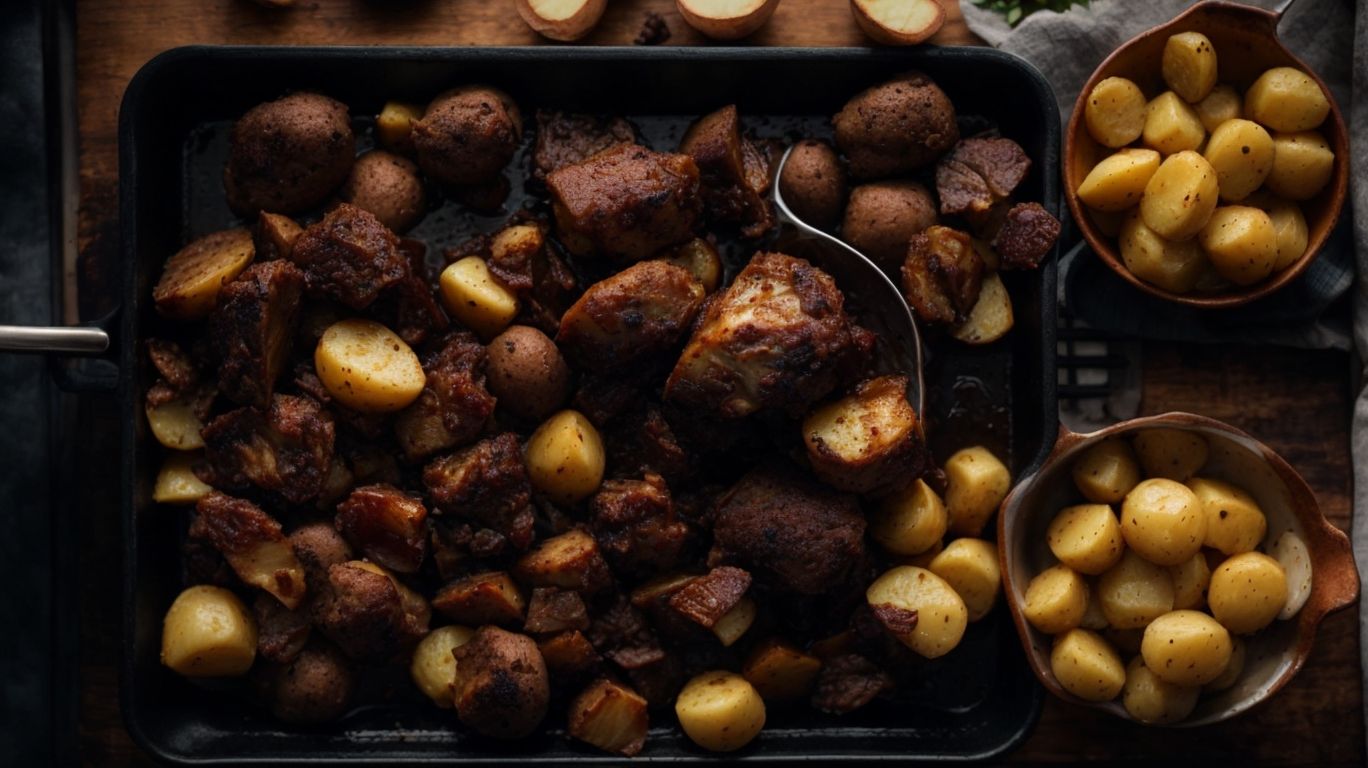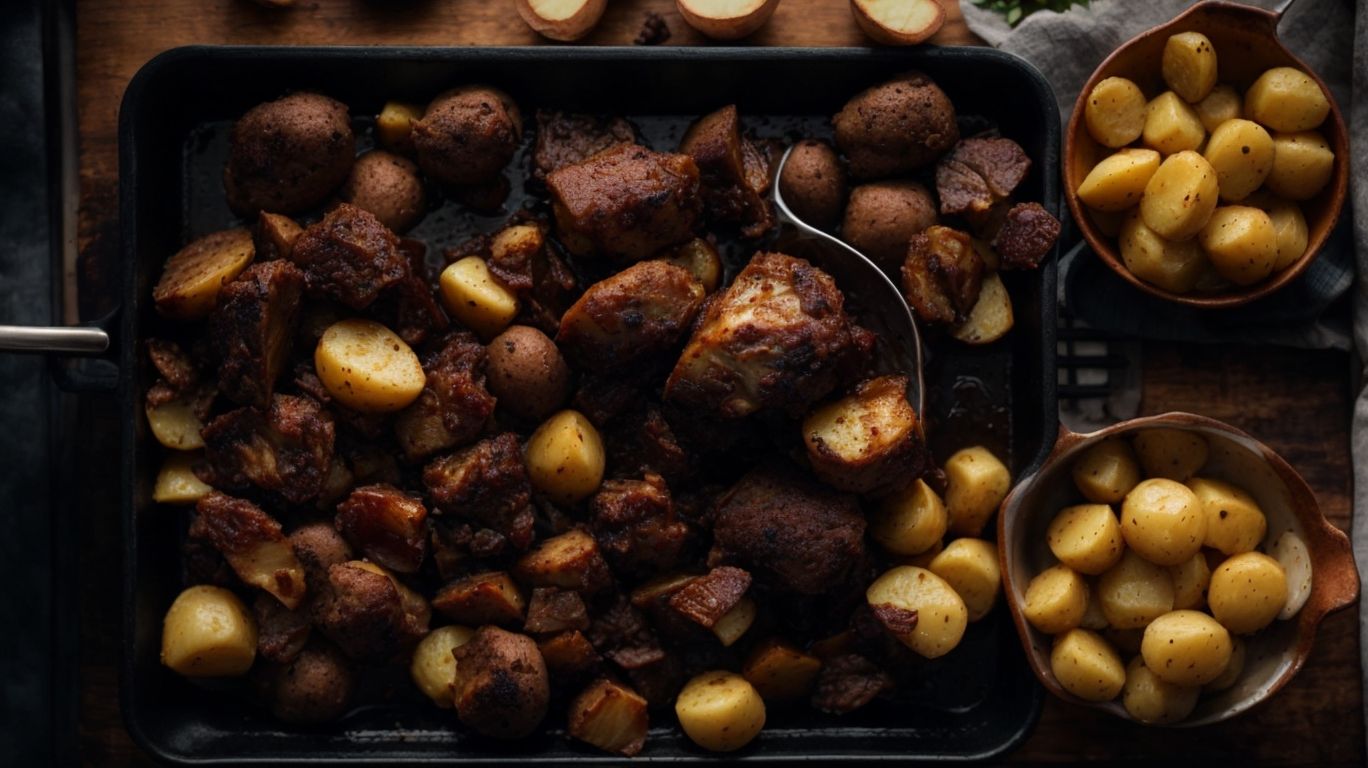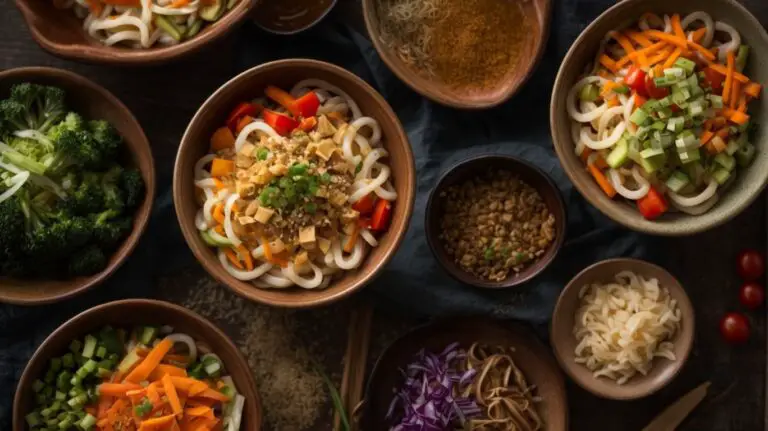How to Cook Neck Bones and Potatoes on the Stove?
Looking to add a flavorful and hearty dish to your cooking repertoire?
Explore the different types of neck bones, what to look for when buying them, and how to prepare them for cooking.
Discover the best ways to cook neck bones on the stove, including essential ingredients and seasonings.
Get ready to impress your taste buds with this delicious recipe!
Key Takeaways:
What Are Neck Bones and How to Choose the Right Ones?
Neck bones are flavorful cuts of meat that can enhance the taste of your dishes. Choosing the right neck bones is crucial for achieving the desired flavor and tenderness.
There are several types of neck bones available, including beef, pork, and lamb neck bones. Each type has its own distinct flavor profile and cooking characteristics. Beef neck bones are known for their rich, beefy flavor, while pork neck bones offer a slightly sweeter taste. Lamb neck bones have a more delicate flavor compared to their beef and pork counterparts.
When selecting neck bones, look for cuts that are well-marbled with fat, as this contributes to moistness and depth of flavor in your dishes. Freshness is key; opt for neck bones that are pinkish-red in color and have no foul odor. Quality neck bones should feel firm to the touch and not slimy or sticky.
To ensure you choose the best neck bones for your recipe, consider visiting a trusted butcher who can provide you with expert advice on selecting the finest cuts. Taking the time to source high-quality neck bones will undoubtedly elevate the taste of your cooking endeavors.
What Are the Different Types of Neck Bones?
Regarding neck bones, you may encounter various types such as beef neck bones, pork neck bones, and lamb neck bones, each offering unique flavors and textures.
Beef neck bones are known for their rich and intense beef flavor, making them perfect for hearty stews and braised dishes. Their high collagen content lends a velvety mouthfeel when slow-cooked.
Pork neck bones, on the other hand, have a slightly sweet and savory taste, ideal for simmering in soups or broths to enhance the overall richness.
Lamb neck bones boast a delicate, gamey taste with a tender yet slightly chewy texture, ideal for slow roasting or grilling for a flavorsome meal.
What to Look for When Buying Neck Bones?
When purchasing neck bones, it is essential to look for cuts that are fresh, have a good meat-to-bone ratio, and exhibit a vibrant color and marbling to ensure a flavorful outcome.
One key tip to remember is to source neck bones from reputable butchers or high-quality meat suppliers to guarantee the best product. These establishments often prioritize freshness and quality, leading to a superior cooking experience.
Inspect the bones for any off-putting odor as it could be a sign of spoilage. At times, opting for organic or pasture-raised options can elevate the flavor profile and overall quality of your dish. Be sure to ask your butcher for specific recommendations on the type of neck bones that would work best for your cooking needs.
Preparing the Neck Bones for Cooking
Before cooking neck bones, it is necessary to clean and trim them to remove excess fat and ensure optimal flavor absorption. Marinating neck bones can enhance their taste and tenderness.
When cleaning neck bones, start by rinsing them under cold water to remove any debris. Use a sharp knife to trim off any visible excess fat or connective tissue. This process not only improves the overall flavor but also prevents the dish from becoming overly greasy.
Marinating the neck bones in a flavorful mixture of spices, herbs, and oils can significantly elevate their taste profile. It helps tenderize the meat and allows the flavors to penetrate deeper, resulting in a more succulent end product.
For various cooking techniques like braising, stewing, or grilling, preparing neck bones involves ensuring they are adequately seasoned and seared before adding them to the main dish. This step is crucial for developing rich flavors and textures in the final preparation.
How to Clean and Trim the Neck Bones?
Cleaning and trimming neck bones involves removing any visible fat, sinew, or impurities to ensure a cleaner taste and appearance in your final dish.
Properly cleaning and trimming neck bones sets the foundation for a flavorful dish. To begin, carefully examine the bones for any excess fat, which can lead to greasiness in the dish. Using a sharp knife, trim off the fat and any tough connective tissue to enhance the tenderness of the meat.
Removing impurities such as bone fragments or blood clots is essential for a cleaner presentation. A boning knife or kitchen shears can be handy tools for this task, allowing for precision and control. By taking the time to perform these steps, you not only improve the aesthetics but also the overall taste and texture of your culinary creation.
Should You Marinate the Neck Bones Before Cooking?
Marinating neck bones before cooking can infuse them with additional flavor, tenderize the meat, and create a more complex taste profile in your dish.
Choosing the right marinade is crucial in enhancing the flavors of neck bones. A simple mix of soy sauce, garlic, and brown sugar brings a perfect balance of sweet and savory notes.
For those seeking a bit of heat, a blend of chili flakes, paprika, and honey can add a delicious kick to the dish. Let the neck bones marinate for at least 2 hours in the refrigerator to allow the flavors to penetrate the meat thoroughly. For even more intense flavor, you can opt for an overnight marination.
Cooking Neck Bones on the Stove
Cooking neck bones on the stove is a versatile and traditional method that allows you to infuse rich flavors into your dishes. Understanding the essential ingredients is key to a delicious outcome.
Regarding simmering neck bones on the stove, the choice of spices can significantly impact the final taste. Incorporating bay leaves and peppercorns can add depth and complexity to the dish. Ensuring that you have a good quality broth or stock as the base will enhance the overall flavor profile.
To achieve tender and flavorful neck bones, it’s crucial to cook them low and slow. This gradual cooking process helps break down the tough connective tissues, resulting in meat that is succulent and falls off the bone effortlessly.
What Are the Different Ways to Cook Neck Bones on the Stove?
When cooking neck bones on the stove, you can opt for methods such as braising, simmering, or stewing to achieve tender, succulent results with rich flavors.
Each technique offers a unique approach to cooking neck bones, producing distinct textures and tastes. Braising involves browning the meat first at a high temperature before slowly simmering it in a flavorful liquid, such as broth or wine, in a covered pot. This method helps lock in the juices, resulting in meat that is moist and incredibly tender.
Simmering requires cooking the neck bones in liquid at a gentle heat, which allows the flavors to meld together slowly. This method is great for infusing the bones with the essence of herbs and spices, creating a well-rounded taste.
Stewing involves cooking the neck bones in a larger amount of liquid for a longer period, ensuring the meat becomes incredibly tender and falls off the bone effortlessly. This method is ideal for creating a hearty, comforting dish with a rich broth that’s perfect for dipping crusty bread into.
What Are the Essential Ingredients for Cooking Neck Bones on the Stove?
To cook neck bones on the stove successfully, you will need essential ingredients such as onions, garlic, vegetable oil, broth, and a blend of flavorful herbs and spices to enhance the dish’s taste.
Onions play a vital role in providing a subtly sweet flavor base, while garlic adds a depth of savory aroma to the dish. Vegetable oil is essential for sautéing the onions and garlic, creating a rich foundation for the neck bones to simmer in. The broth acts as the liquid component, infusing the meat with moisture and additional flavor. Herbs like thyme, rosemary, and bay leaves add complexity and fragrance, enhancing the overall taste profile.
How to Prepare the Potatoes for Cooking?
Preparing potatoes for cooking involves washing, peeling, and cutting them into uniform pieces. Russet and Idaho potatoes are popular choices for pairing with neck bones in many recipes.
Regarding Russet potatoes, they have a higher starch content and are great for baking, mashing, or frying. On the other hand, Idaho potatoes, also known as baking potatoes, have a fluffy texture, making them ideal for roasting or grilling alongside flavorful neck bones. To complement the savory flavors of the dish, consider seasoning the potatoes with herbs like rosemary, thyme, and garlic. You can also enhance their taste by drizzling them with olive oil or butter before baking or sautéing.
Combining Neck Bones and Potatoes in One Dish

Credits: Poormet.Com – Wayne Robinson
Combining neck bones and potatoes in a single dish creates a hearty and flavorful meal that is perfect for showcasing the rich taste of the meat and the comforting texture of the potatoes.
This pairing offers a multitude of benefits. Neck bones, being a cut with rich marrow and connective tissues, impart a luscious, savory flavor to the dish while also providing essential nutrients. Potatoes, on the other hand, add a comforting starchiness that complements the meat perfectly. When seasoned thoughtfully, the dish can reach new heights of taste. Consider using classic herbs like thyme and rosemary, along with a hint of paprika for added depth.
Layering the ingredients strategically is key to achieving a well-balanced dish. Start by placing the neck bones at the bottom of the cooking vessel to ensure they cook thoroughly. Add a layer of thinly sliced potatoes on top, seasoning each layer generously to enhance the flavors throughout. Continue this process until all ingredients are used, creating a harmonious blend of tastes and textures that will delight your taste buds.
What Are the Best Seasonings and Spices to Use for This Dish?
The best seasonings and spices to enhance the flavor of neck bones and potatoes include salt, black pepper, paprika, dried thyme, bay leaf, parsley, and cilantro, creating a harmonious blend of aromas and tastes.
Each seasoning plays a crucial role in elevating the dish. Salt adds depth and enhances the natural flavors of the ingredients, while black pepper provides a gentle heat and earthiness. Paprika contributes a smoky sweetness, and dried thyme brings a subtle herbaceous note. The bay leaf infuses a complex aroma, and parsley adds a fresh, bright flavor. Finally, cilantro lends a hint of citrusy freshness.
To personalize the seasoning, adjust the quantities based on your preference. For a spicier kick, increase the black pepper level, or add a pinch of cayenne pepper. If you prefer a more herb-forward profile, boost the dried thyme and parsley amounts. Experiment with the seasonings until you achieve a flavor combination that delights your palate.
How to Properly Layer the Neck Bones and Potatoes in the Pot?
Layering neck bones and potatoes in the cooking pot requires strategic placement to ensure even cooking and flavor infusion. Proper layering enhances the overall dish presentation and taste.
Begin by placing a layer of thinly sliced potatoes at the bottom of the pot. This acts as a natural barrier to prevent the bones from sticking to the surface and burning. Next, carefully position the neck bones on top of the potatoes in a single layer, ensuring they are evenly spaced to allow heat distribution.
Alternate the process by adding another layer of potatoes on top of the bones. This repetition helps to build flavor as the ingredients cook together. Depending on the desired outcome, consider adjusting the layering technique for slow cooking or pressure cooking methods to achieve varied textures and aromas.
Serving and Storing the Dish
Serving the neck bones and potatoes dish is a delightful experience that showcases the combination of flavors and textures.
When presenting this hearty meal, consider garnishing with a sprinkle of finely chopped fresh herbs, such as parsley or chives, to add a touch of freshness. Accompanying this dish with a side of sautéed greens or a simple salad can complement the rich flavors of the neck bones and potatoes.
For storing leftovers, ensure that the dish is cooled to room temperature before transferring it to an airtight container. Remember to label the container with the date before placing it in the refrigerator to maintain freshness and quality for up to 3-4 days.
How to Serve the Neck Bones and Potatoes Dish?
Serving the neck bones and potatoes dish involves arranging the components attractively on a plate, garnishing with fresh herbs like parsley, and presenting it in a visually appealing manner that enhances the dining experience.
To begin, place the tender, succulent neck bones alongside the golden-brown potatoes in an organized fashion on the plate. Consider using a bed of wilted spinach as a base to elevate the dish aesthetically and add a touch of vibrant green to the presentation. Sprinkle some freshly chopped chives over the dish for a hint of color and flavor. For an extra element of sophistication, drizzle a savory jus over the tender meat.
Regarding side dishes, opt for buttery mashed sweet potatoes or a crisp green salad with a zesty vinaigrette to complement the richness of the neck bones and potatoes. These sides will balance the flavors and textures, creating a well-rounded dining experience for you and your guests.
Can You Store Leftovers and Reheat Them?
Leftovers of the neck bones and potatoes dish can be stored in airtight containers in the refrigerator for up to a few days. Reheating leftovers can be done on the stovetop or in the microwave for a quick and convenient meal.
When storing the leftovers, it’s essential to use containers that seal tightly to prevent air exposure, which can lead to faster spoilage. Opt for glass or plastic containers with secure lids to maintain freshness and prevent odors from permeating the dish.
For optimal shelf-life, label the containers with the date of preparation to track freshness. When reheating the dish, it’s best to gently warm it on medium heat on the stovetop. Adding a splash of broth or water can help retain moisture and flavors during reheating.
Frequently Asked Questions
Can I cook neck bones and potatoes on the stove?
Yes, you can definitely cook neck bones and potatoes on the stove. It is a great option for those who do not have access to an oven or grill.
What are the steps to cook neck bones and potatoes on the stove?
The first step is to brown the neck bones in a large pot on medium-high heat. Then, add chopped potatoes and enough water or broth to cover the bones. Let it simmer for about an hour until both the neck bones and potatoes are tender.
Do I need to season the neck bones and potatoes before cooking?
Yes, it is recommended to season the neck bones and potatoes with your choice of herbs and spices. This will enhance the flavor of the dish and make it more delicious.
How long does it take to cook neck bones and potatoes on the stove?
It typically takes about an hour to cook neck bones and potatoes on the stove. However, the cooking time may vary depending on the size of the neck bones and the type of potatoes used.
Can I use any type of neck bones for this recipe?
Yes, you can use any type of neck bones such as beef, pork, or lamb. However, the cooking time may vary depending on the type of meat.
Can I substitute potatoes with other vegetables?
While potatoes are the traditional choice for this recipe, you can certainly substitute them with other root vegetables like carrots or turnips. This will add a different flavor and texture to the dish.






